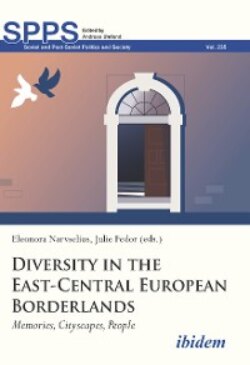Читать книгу Diversity in the East-Central European Borderlands - Группа авторов - Страница 7
На сайте Литреса книга снята с продажи.
Introduction1
ОглавлениеThis volume explores the urban environments of the East-Central European borderlands, bringing to the fore the material and symbolic landscapes of four historically interconnected cities. Wrocław, Lviv,2 Chernivtsi, and Chişinău were stripped of their historical populations in the twentieth century and continue to wrestle with the legacies of Nazism, Marxist-Leninism, and radical ethno-nationalism. These “peripheral cities in the middle of Europe”3 have by no means been “typical” sluggish provincial spots populated by people with uncertain identities and shifting loyalties; throughout history they were at the epicenter of pan-European and global political processes, trade, transcultural exchange, and the clashes of grand ideologies. Since the collapse of communist regimes, these cities have been keen to project an image of themselves as hubs of cultural diversity generating innovative spaces, inclusive identities, and multicultural common heritage (Murzyn 2008: 317). However, the actual state of affairs is more complicated; in fact, these urban landscapes provide plenty of examples of plural mono-ethnic heritage, while multi-ethnic hybridity and mutual engagement are less mainstream. A good deal of evidence indicates that although these cityscapes might function as effective channels for transmission of an array of outlooks, attitudes, and values, the surface impression of inclusive identities, tolerance, and peaceful sharing of the urban space may be misleading.
The most recent and memorable watershed addressed in each article is the collapse of the Soviet-dominated political system. While post-socialist transformations of urban landscapes and the quest for new urban identities have been addressed in a bulk of academic publications (see, for example, Czaplicka, Ruble, and Crabtree 2003; Huyssen 2003; Stanilov 2007; Czepczyński 2008; Young and Kaczmarek 2008; Bartetzky, Dmitrieva, and Kliems 2009; Czaplicka, Gelazis, and Ruble 2009; Darieva, Kaschuba, and Krebs 2011; Diener and Hagen 2013; Diener and Hagen 2015; Krase and Uherek 2017), much less is known about the ways in which contemporary urbanites make sense of cityscapes stripped of their historical population groups, and how they handle the history and memory of these populations.4 How, and more importantly, why do contemporary residents invoke historical diversity and make of it a closed or an open-ended resource? What has changed since the previous socialist/Soviet epoch? Above all, what do contemporary transformations of the cityscapes tinted by the presence of historical “others” say about the present-day societies?
In the words of Henri Lefebvre, “City is forged as an appropriated space” (Lefebvre 1991: 31); cityscapes constantly produce new “lived, conceived and perceived realms” of representation and action (ibid.: 40). The fractured spatial texture of contemporary borderline cities is particularly suitable for experiments with (re)appropriations of “foreign” spaces, (radical) re-drawings of borders between “otherness” and “outness,” and the (selective) recall of forgotten pasts. To facilitate analysis of these processes and without getting bogged down in their historiography, this introductory essay scrutinizes contemporary engagements with the lost diversity and appropriations of the East-Central European cityscapes. In particular, it makes the case for combining broader conceptualizations of borderlands, cosmopolitan sociality, and hybridity with theoretical propositions drawn from the field of Memory Studies.
